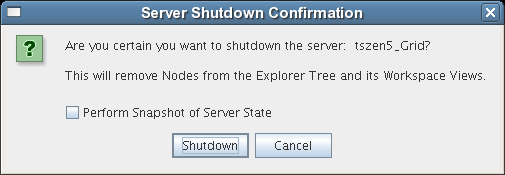22.3 Snapshotting the Existing Orchestration Server Installation
Before you begin the upgrade process of the Orchestration Server, ensure that all running jobs are complete and take a snapshot of the current configuration of the Orchestration server. If the jobs have not completed on their own, the upgrade processes forcibly cancels them, which is the normal behavior when the server is shut down. The effect on the jobs is that they are terminated abruptly before they finish running. The specific consequence of this termination depends on the job that is terminated.
When you are sure that the jobs are complete, you need to run a specific shutdown command to prepare a snapshot of the current configuration of the server so that a new version of a server can be started with the configuration of the old server.
When an upgrade of server components occurs, all of the current server settings (configuration) and state (model) for the current instance is written to a platform-independent XML encoded snapshot. This snapshot is read in by a newly upgraded server instance to initialize its settings and state to that of the previous server instance.
The snapshot data is read when a newly upgraded server instance is first started, initializing its settings and its state to that of the previous server instance. The snapshot files must exist in /var/opt/novell/zenworks/zos/server/snapshot.
To perform the snapshot:
-
Check the running status of the server:
/etc/init.d/netiq-cmosserver status
If the Orchestration Server is already stopped, you must start it before a snapshot can be created:
/etc/init.d/netiq-cmosserver start
-
Create a snapshot of the server’s current configuration with the following command:
/etc/init.d/netiq-cmosserver stop --snapshot
You can also create the snapshot by using the Orchestration Console to shut down the server. To do so, select Server > Shutdown Server to display the Server Shutdown Confirmation dialog.

Select Perform Snapshot of Server State, then click Shutdown.